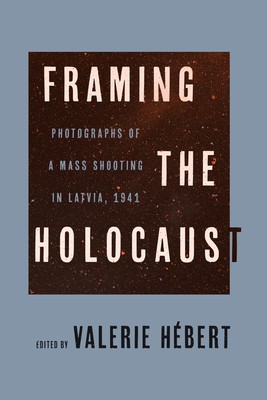
- We will send in 10–14 business days.
- Publisher: University of Wisconsin Press
- ISBN-10: 029934410X
- ISBN-13: 9780299344108
- Format: 15.2 x 22.9 x 2.1 cm, kieti viršeliai
- Language: English
- SAVE -10% with code: EXTRA
Framing the Holocaust (e-book) (used book) | bookbook.eu
Reviews
Description
In December 1941, German police and their local collaborators murdered 2,749 Jews at the beach in Sķēde, near Liepāja, Latvia. Twelve photographs were taken at the scene. These now-infamous images show people in extreme distress, sometimes without clothing. Some capture the very moments when women and children confronted their imminent deaths, while others show their dead bodies. They are nearly unbearable to look at--so why should we? Framing the Holocaust offers a multidimensional response to this question.
While photographs are central to our memory of modern historical events, they often inhabit an ambivalent intellectual space. What separates the sincere desire to understand from voyeuristic curiosity? Comprehending these images requires the viewer to place oneself in the very positions of the perpetrator who took the images. When we engage with atrocity photographs, do we risk replicating the original violence? In this tightly organized book, scholars from Holocaust studies, modern European history, Jewish studies, visual studies, and the history of photography examine the images of the Liepāja atrocity, giving historical, contextual, political, and moral depth to the act of looking and interpreting. With a foreword by Edward Anders, who narrowly escaped the December shooting, Framing the Holocaust represents an original approach to an iconic series of Holocaust photographs. This book will contribute to powerful debates in the emerging field of visual history, including the challenges and responsibilities of teaching about atrocity.EXTRA 10 % discount with code: EXTRA
The promotion ends in 22d.10:41:45
The discount code is valid when purchasing from 10 €. Discounts do not stack.
- Publisher: University of Wisconsin Press
- ISBN-10: 029934410X
- ISBN-13: 9780299344108
- Format: 15.2 x 22.9 x 2.1 cm, kieti viršeliai
- Language: English English
In December 1941, German police and their local collaborators murdered 2,749 Jews at the beach in Sķēde, near Liepāja, Latvia. Twelve photographs were taken at the scene. These now-infamous images show people in extreme distress, sometimes without clothing. Some capture the very moments when women and children confronted their imminent deaths, while others show their dead bodies. They are nearly unbearable to look at--so why should we? Framing the Holocaust offers a multidimensional response to this question.
While photographs are central to our memory of modern historical events, they often inhabit an ambivalent intellectual space. What separates the sincere desire to understand from voyeuristic curiosity? Comprehending these images requires the viewer to place oneself in the very positions of the perpetrator who took the images. When we engage with atrocity photographs, do we risk replicating the original violence? In this tightly organized book, scholars from Holocaust studies, modern European history, Jewish studies, visual studies, and the history of photography examine the images of the Liepāja atrocity, giving historical, contextual, political, and moral depth to the act of looking and interpreting. With a foreword by Edward Anders, who narrowly escaped the December shooting, Framing the Holocaust represents an original approach to an iconic series of Holocaust photographs. This book will contribute to powerful debates in the emerging field of visual history, including the challenges and responsibilities of teaching about atrocity.

Reviews